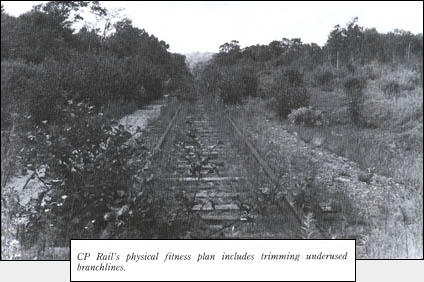Vol. 17 No. 8
August, 1987
|
Stay Safe in 87
|
|
Serving Low-Density Rail
Lines
Part of "Physical Fitness" Goal

Montreal - As CP Rail
takes a long, hard look at itself, the word "abandonment" often crops up.
It's a word that not only creates a negative image, its also one that simply doesn't do the job when a railway is
trying to make itself more efficient and more responsive to the needs of customers and markets caught in the
whirlwind of global economic change.
Perhaps rail line abandonment could be better described as "physical fitness". Just as many of us are
trying our best to improve our health through exercise, so too the railway is doing many things to make itself
trimmer - and healthier.
The railway's physical fitness program involves much more than merely lopping off sections of track here and there
that aren't carrying their weight economically.
CP Rail has many good customers who've provided the railway with a lot of business over the years; customers who've
traditionally moved their goods to markets over the many hundreds of kilometres of branch lines.
COMBINATION OF MODES
The railway doesn't want to turn it back on this business. It simply wants to work out methods so customers can
continue to receive good service, but perhaps by using a combination of transportation modes, rather than being
restricted to using low-density lines that don't provide the railway with enough money to ensure
efficient service.
While the market generally no longer uses rail in the same ways it did 20 years ago, the railway is still operating
a track network based on the needs and expectations of half a century ago. For example, today 54 percent of CP Rail's
route kilometres carry only three percent of its workload.
SEVERE CONSTRAINT
And, with many low-density lines in a loss position, or only marginally viable, a severe constraint is
placed on the railway's ability to provide competitive service - because funds needed for investment in new or
improved railway facilities and services are being siphoned away to maintain a direct-rail service for
which there isn't enough demand or revenue.
In aiming for its goal of physical fitness, the railway's first objective as a business is to determine if there are
better, more flexible ways to provide service to customers on low-density lines.
For many customers, this goal can be accomplished through the use of intermodal facilities that combine the
efficiencies of truck and rail.
In some parts of the country, regional or "short-line" railways have been proposed. CP Rail
supports this concept if regional operators can be viable. In some cases, this would require the ability to operate
in a lower cost environment.
VESTED INTEREST
Where CP Rail may no longer be able to participate in continuing to serve some of its customers, it still has an
interest in helping them to identify alternative shipping arrangements.
During the past 20 years, as competition has intensified, CP Rail has developed many new ways to serve its customers
and help keep Canadian products competitive on world markets.
- Unit and solid train systems have been developed to handle such bulk commodities as coal, potash, sulphur, and
grain;
- Intermodal services have grown at a dizzying rate. Trailers-on-flatcars (TOFC) and
containers-on-flatcars (COFC) mean many shippers no longer need sidings or branch lines to be
served by rail.
- Specialized rail-truck transfer systems have helped focus transportation needs for such products
as plastics, potash, lumber, and automobiles;
- Across Canada, the railway is becoming more and more a system that links major hubs, supplemented by terminals
providing highway service extensions, as well as transfer facilities for specialized products.
Physical fitness doesn't simply begin one day and end the next. It's a continuing process - whether it's a person's
exercise program or the railway's program of becoming more efficient and more profitable.
It's a process that cannot be deferred.
This CP Rail News article is copyright
1987 by the Canadian Pacific Railway and is reprinted here with
their permission. All photographs, logos, and trademarks are the property of the Canadian Pacific Railway
Company.
|